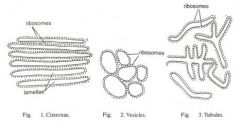![]()
![]()
![]()
Use LEFT and RIGHT arrow keys to navigate between flashcards;
Use UP and DOWN arrow keys to flip the card;
H to show hint;
A reads text to speech;
15 Cards in this Set
- Front
- Back
|
- What are the three main differences between animals and plants?
|
- Plants are autotrophic (animals are heterotrophic) - Plants don't have a skeleton - animals do - plants are sessile (stuck in soil), animals are motile |
|
|
What is an autotroph?
|
- organism that converts sunlight into usable energy - e.g. plants - convert nutrients (CO2, H2O, inorganic ions) into all intermediates essential for synthesis of: - nucleic acids, proteins, lipids and polysaccharides, as well as numerous secondary metabolites |
|
|
Structural differences between plant cells and animal cells:
|
- size - animal - 10-30um, plant - 10-100um - plant has extra components - vacuole, chloroplast, cell wall |
|
|
What is the purpose of the cell wall and what is its composition?
|
- serves for rigidity - play a role in absorption, transport and secretion - it is arranged into layers of cellulose microfibrils, which are embedded into a matrix composed of pectin and hemicellulose. |
|
|
What is the structure of the chloroplast?
|
- outer and inner membrane - stroma - enzymes that catalyse CO2 fixation and starch synthesis inside the chloroplast - thylakoid membrane - absorption of light by chlorophyll, synthesis of ATP, NADPH and electron transport - Granum - stack of thylakoids |
|
|
What is a vacuole?
|
- organelle bound by a single membrane (tonoplast) - stores food (proteins in seeds), various ions (Ca, Na, Fe), stores/degrades wastes - maintains turgor (and rigidity) in the cell - young cells have many small ones, mature - one large central vacuole (90% of volume) |
|
|
What is the endosymbiotic theory?
|
- Explains the origin of chloroplasts and mitochondria inside cells, as well as their double membranes - aerobic prokaryotes engulfed by anaerobic prokaryotes = early eukaryotes - 2-3.5 billions years ago? |
|
|
Plant and animal cells in different solutions:
|
Hypotonic - animal =lysed, plant=turgid (normal) Isotonic - animal = normal, plant = flaccid Hypertonic - animal=shrivelled, plant = plasmolysed |
|
|
Plants have two types of vacuoles:
|
- lytic (same as lysosomes in animal cells) = degrade endocytosed (brought from outside by membrane invagination) and autophagosomes ( vesicles carrying proteins/organelles for degradation); turgor - storage - (carbs, proteins, lipids, defence chemicals) |
|
|
What are trans-vacuolar strands? |
- thin tubular structures that traverse the vacuole - depend on actin filaments - provide connection between perinuclear cytoplasm and cortical cytoplasm in distant parts of the cell - involved in anchoring the nucleus to e certain position in the cell |
|
|
What is the endoplasmic reticulum?
|
- network of interconnected membranous structures contigious with the nuclear envelope; - RER - associated with ribosomes= synthesis and processing of proteins - SER - lacks ribosomes, functions in lipid synthesis |
|
|
The ER can form in different ways: |

- cisternae - vesicles - tubules |
|
|
What is the difference between ER in animals and ER in plants?
|
- in animal cells - microtubule dependent - in plant cells - actin & myosin dependent |
|
|
What is the Golgi apparatus?
|
- stack of cisternae that function in processing and sorting of proteins and lipids destined for other cellular compartments OR for secretion - up to 8 cisternae in plants |
|
|
What are the 5 models of Golgi development and what do they suggest?
|
1) Vesicular Shuttle model - vesicular transport between stable compartments 2) cisternal progression/maturation 3) cisternal maturation with heterotypic tubular transport 4) rapid partitioning in a mixed Golgi 5) stable compartments as cisternal progenitors |

